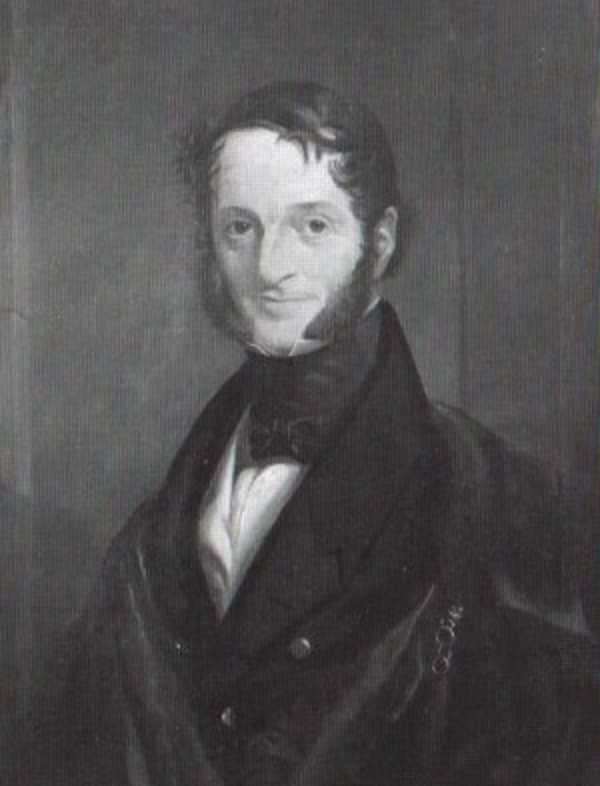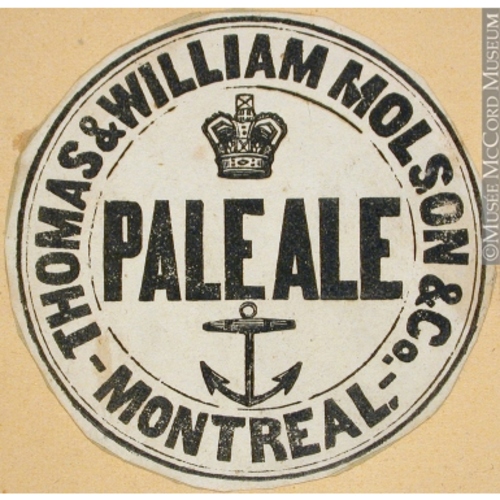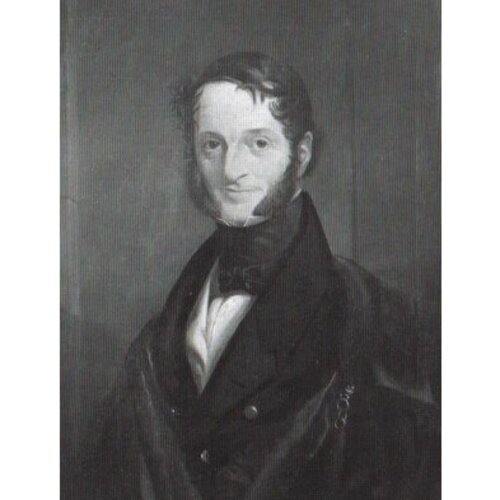
Source: Courtesy of Wikimedia Commons
MOLSON, THOMAS, brewer, distiller, miller, and merchant; b. 1 Sept. 1791 at Montreal, second son of John Molson* Sr and Sarah Insley Vaughan; d. 22 Feb. 1863 at Montreal.
No primary sources describe Thomas’ childhood and adolescence. The earliest reference to him is in a letter written in 1811 by his elder brother John* to his father, John Sr, who was in England to purchase an engine for the Molsons’ second steamship the Swiftsure, launched in 1812. The letter tells us that the two brothers were running the brewery at Montreal.
In 1816 Thomas went to England, where he married Martha Molson, his first cousin, without making a marriage settlement. On his return to Montreal, he entered into partnership with his father and two brothers, John and William*, under the name of John Molson and Sons. Thomas was made responsible for the brewery, and he expressed satisfaction at his early success. In December 1816 he recorded in his notebook: “The beer we have for sale now and the past month is far superior to any made in Montreal, viz. [Miles] Williams, [Francis and John] Chapman, [James] Stevenson, by the customers’ account of it and their getting of us, viz. J. Molson and Sons, brewed by Thos. Molson.” The partnership, which lasted seven years, managed all the family assets (most of which belonged to the father), including the brewery, ships, wharves and storehouses at Montreal and Quebec, and a hotel. An 1816 inventory of the business also listed a still. Thomas’ notebooks indicate that he was experimenting with distilling by 1822, and that he attempted to export whisky to England through his brother William, who was then living at Quebec. In 1822 also, the St Lawrence Steamboat Company was founded and through it the Molsons would control all steamship navigation on the St Lawrence. Collectively they held 26 of the company’s 44 shares; individually each held six and a half shares.
When the firm of John Molson and Sons came to an end in 1823, Thomas decided to leave Lower Canada, where the marriage laws imposed community of property on couples who had married without a marriage settlement. He thought of settling in England, but finally decided on Kingston, Upper Canada. He made two trips to England in 1823 and bought brewing equipment there. In July 1824 he purchased the Kingston brewery and land of Henry Murney. He settled at Kingston with his family and was a neighbour of Thomas Markland*, a founder of the “pretended” Bank of Upper Canada, who, after this bank was closed, had become an agent of the Bank of Montreal. Markland remained its agent until 1824, when an Upper Canadian law prohibited on its territory any branch of a bank established by a law promulgated by another government. During the ten years he spent at Kingston, Thomas lived a relatively quiet life. The town’s newspapers only mention him in connection with his brewing and distilling business. In 1831 he bought a second business, Thomas Dalton*’s Kingston Brewery and Distillery. In the English style, he became the owner of the taverns connected with this business. He invested in land outside Kingston, buying a 100-acre parcel at Ameliasburg in 1828, and in 1829 300 acres at Portland, near Rideau Lake. In 1832 he helped found the Commercial Bank of the Midland District. Six of the 11 children of Thomas and Martha were born at Kingston. Five of them, Martha Ann (1824), John Henry Robinson (1826), Mary Ann Elizabeth (1828), Harriet Bousfield (1830), and William Markland (1833), survived their parents, as did John Thomas who was born at Montreal in 1837.
Thomas returned to Montreal in 1834 to go into partnership with his father and his brother William. William had just begun distilling at their businesses in Montreal, and Thomas was probably invited to come because of his experience as a distiller. Moreover, John Molson Sr, who was to die in 1836, had found a way of getting round the consequences of the community of property of Thomas and Martha: he would entail the breweries in Montreal on their eldest son, John Henry Robinson, on condition that Thomas and William manage them until his grandson reached the age of majority. The biography of William Molson [see DCB, X] describes the two brothers’ partnerships from 1834 to 1852 as brewers and distillers (John Molson and Company in 1834, Thomas and William Molson in 1837, Thomas and William Molson and Company in 1838, and Thomas and William Molson and Company in 1848), and their joint personal and financial undertakings.
Throughout this long period Thomas diversified his interests and increased the holdings he shared with his brother William in the Montreal distillery. In the 1840s he bought several pieces of land and houses in the district near the distillery: in 1850 his statement for land taxes owing to the city of Montreal concerns 68 plots of land and houses. He bought a large farm at Sherrington, in Huntingdon County. In 1847 the New City Gas Company of Montreal was set up, in competition with the Montreal Gas Light Company, founded in 1836. From the beginning Thomas sat on the board of directors of the new company, which in 1848 acquired all the assets of the first; he became president in 1857, and in 1859 in recognition of long, valuable, and disinterested contribution to the company he received a silver service valued at £250 ($1,000). By 1846 he had become involved in a new investment in Upper Canada (until the end of his life he retained all his Kingston premises, which he had rented since 1834). This time he bought a distillery at Port Hope, Crawford’s Distillery; then, in 1851, he acquired the large establishment known as Brownston Mills, which included a flour mill, sawmill, and distillery. He leased the two distilleries, but until his death he ran the sawmill and flour mill through a manager, Robert Orr; he himself sold the flour on the Montreal Corn Exchange through his brokers, John and Robert Esdaile; this flour was intended for export to England. Molsons Bank was set up in 1853, in accordance with the 1850 law controlling private banks, and in 1855 it became a chartered bank; Thomas assisted its development by circulating its notes in the Port Hope region, and even in the American Midwest when he bought grain at Chicago.
During the 1840s Thomas and his brother William built St Thomas’ Church in the Sainte-Marie district of Montreal. The church was destroyed, as were 49 of Thomas’ houses, in the great fire of 1852. Thomas built a new church in 1855, but fell out with the Church of England bishop of Montreal, Francis Fulford, because he himself wanted the right to appoint the parish priest of his church. He then brought in a new Methodist sect of an aristocratic character, the Countess of Huntingdon’s Connexion, founded in England in the mid 18th century. In 1857 parliament conferred upon the ministers of this church the right to keep registers of baptisms, marriages, and burials, and to celebrate marriages. In the same year, Molson had a college built for training clergy of the new sect; some 20 students were enrolled in 1858. However, in 1860 the church’s minister, Alfred Stone, resigned; when British troops arrived in Montreal during the American Civil War, Thomas rented the college and several houses as army billets. The rental contract was renewed in February 1863, but this time it included the church itself. In his will Thomas bequeathed the temple and 11 houses to the Church of England, which had modified its rules to allow groups to own churches and appoint their own priests.
Thomas’ eldest son John Henry Robinson had gone into partnership with him and his uncle William in the firm incorporated in 1848 as Thomas and William Molson and Company; at the same time, by two other contracts, the young man was given possession of the brewery bequeathed to him by his grandfather, and was released from the obligations of an apprenticeship deed by which he had been bound to Thomas and William since 1844. A new company bearing the same name and bringing together father and eldest son was formed in 1853, when William resigned. In 1859, by a new contract, Thomas’ second son, William Markland, became a partner in the firm, which continued under the same name. However, another partnership, John H. R. Molson and Brothers, was formed in 1861; when John Thomas joined his two elder brothers, Thomas ceased to be a partner; he leased his distillery, and granted a loan to the new company.
On 25 Aug. 1859 Thomas married Sophia Stevenson of Port Hope. During a trip with her to England, he planned to request the queen to elevate him to the peerage. Presumably this request was not presented, for no record of it exists in the Public Record Office, the Home Office, or the Privy Council. Thomas Molson died on 22 Feb. 1863 and was buried in the Protestant cemetery at Mount Royal, in the family vault that he and his brothers had constructed in 1860, at a cost of $15,000, to receive their own and their parents’ remains.
Thomas Molson can be seen, in the context of 19th century entrepreneurship and the evolution of capitalism in the colonies, to be reacting against the structures of the dominant economic system, the large-scale export-import trade. Similarly he was unable to adapt to the joint-stock company then developing, as did his brother William. True, he did undertake large-scale export of flour, but only by selling to exporters at Montreal; he was also a shareholder of companies such as the New City Gas Company of Montreal, the Canadian Grand Trunk Railway Company, and Molsons Bank. But he was always and above all an industrialist who, with some exceptions, financed his undertakings himself, managed them directly, and personally looked after all phases of production and marketing. Thomas Molson gave little responsibility to his manager in the running of the sawmills and flour mill at Port Hope. Although he left a relatively large fortune (which can be assessed at a minimum of $1,000,000), he was not always capable of overcoming the fundamental contradiction of the firm that combines the functional relations of business and the emotional relations of family: witness the difficulties that constantly set him on the one hand against his elder brother, and on the other against his sons. Nevertheless by determination he built a successful career against all odds.
[Sources of information on Thomas Molson are scattered in various archives. Among the most important are the following: the proceedings of the meetings of the board of directors and of the shareholders in the Molsons Bank Archives (preserved at the head office of the Bank of Montreal) and in the Bank of Montreal Archives; proceedings of the meetings of the board of directors in the Montreal Board of Trade Archives; proceedings of city council in the AVM; the registers of notaries Thomas Barron, I. J. Gibb, Henry Griffin, J. C. Griffin, J. S. Hunter, William Ross, and James Smith at ANQ-M; Molson papers at the Château de Ramezay (Montreal) and in the McCord Museum; the William Molson coll. in McGill University Libraries; and manuscript material at QUA and documents in the registry office in Kingston.
The most important repository is the Molson Company Archives (Molson’s Brewery Ltd., Montreal), and its contents are described in an inventory prepared in 1955 (copy in PAC, MG 24, D1). The following volumes were consulted for this article: 144, 321–23, 327–28, 350–52, 355–57, 360–70, 372–74, 383–91. The Adam Shortt papers at the PAC (MG 30, D45) also contain interesting information on Molson. a.d.]
Merrill Denison, Au pied du courant; l’histoire Molson, Alain Grandbois, trad. ([Montréal], 1955); Première banque au Canada. Alfred Dubuc, “Thomas Molson, entrepreneur canadien: 1791–1863” (thèse de doctorat, université de Paris, 1969; en cours de publication). Father’s rest (Montreal, n.d.). Georges Ripert, Aspects juridiques du capitalisme moderne (Paris, 1946). B. K. Sandwell, The Molson family (Montreal, 1933). B. E. Walker, A history of banking in Canada; reprinted from “A history of banking in all nations”. . . (Toronto, 1909). F. W. Wegenast, The law of Canadian companies (Toronto, 1931). G. H. Wilson, “The application of steam to St. Lawrence valley navigation, 1809–1840” (unpublished ma thesis, McGill University, Montreal, 1961). Alfred Dubuc, “The advent of banking credit on the guarantee of warehouse receipts in Canada,” Canadian Banker (Toronto), 70 (1963), no.4, 51–54; “La crise économique au Canada au printemps de 1848; quelques considérations tirées de la correspondance d’un marchand,” Recherches sociographiques (Québec), III (1962), 317–22; “Montréal et les débuts de la navigation à vapeur sur le Saint-Laurent,” Revue d’histoire économique et sociale (Paris), XLV (1967), 105–18.
Cite This Article
Alfred Dubuc, “MOLSON, THOMAS,” in Dictionary of Canadian Biography, vol. 9, University of Toronto/Université Laval, 2003–, accessed December 17, 2025, https://www.biographi.ca/en/bio/molson_thomas_9E.html.
The citation above shows the format for footnotes and endnotes according to the Chicago manual of style (16th edition). Information to be used in other citation formats:
| Permalink: | https://www.biographi.ca/en/bio/molson_thomas_9E.html |
| Author of Article: | Alfred Dubuc |
| Title of Article: | MOLSON, THOMAS |
| Publication Name: | Dictionary of Canadian Biography, vol. 9 |
| Publisher: | University of Toronto/Université Laval |
| Year of publication: | 1976 |
| Year of revision: | 1976 |
| Access Date: | December 17, 2025 |




